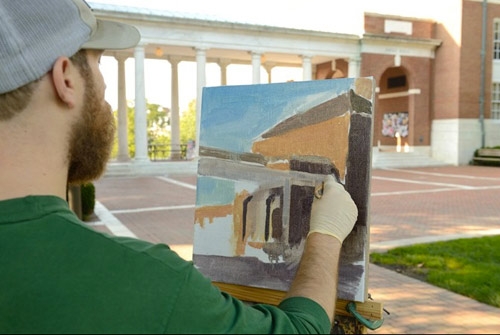
Johns Hopkins University in Baltimore enjoys a sterling reputation as a research university. But the institution has learned to value artistic expression as well.

The arts program at Johns Hopkins, a research university, recently celebrated its 40th year.
This year marked the 40th anniversary of Homewood Art Workshops, the university’s fine arts program. It started as non-credit figure-drawing sessions in a basement. It now has eight instructors and a new name — the Center for Visual Arts. The director of the program, Craig Hankin, says working in the visual arts allows Johns Hopkins students to enhance their problem-solving abilities.

A student studies the scene during a plein air session.
“My colleagues in the Homewood Art Workshops have found that the creative processes and problem-solving strategies we teach benefit our students in their other course work, as well,” Hankin wrote last year in a university magazine. “The arts teach people to look at reality from different angles. They teach creativity, which is applicable and valuable in every avenue of human endeavor. They teach skills, including perceptual skills, which actually improve the process of thinking and reasoning. In fact, the ability to be flexible in the interpretation of data is a key component of success in research, and making art helps students develop exactly this sort of cognitive flexibility. Why wouldn’t a research university — or a potential employer — want individuals who are also trained to think outside the box, who have been taught to look beyond the expected outcome and consider additional and unexpected possibilities?”

The Baltimore campus offers several motifs for Johns Hopkins University artists.
The Center for Visual Arts recently celebrated its big birthday with a plein air event that drew 40 artists to the campus grounds on a Saturday. That night, the pieces were auctioned off, with 30 percent of the proceeds going to the center. Hankin isn’t surprised that the plein air event proved popular. “Our students, who come from every academic discipline across the board, tell us they value plein air painting for the opportunity to be out of the classroom/lab environment and in touch with the natural world,” says Hankin. “Almost without exception, they cite the blessed relief of not looking at electronic screens for a few hours. ‘It’s my one chance during the week to feel like a human being again and not just a brain in a jar,’ one of my best students told me recently.”





Now that takes the cake. I really need a wife;-)))